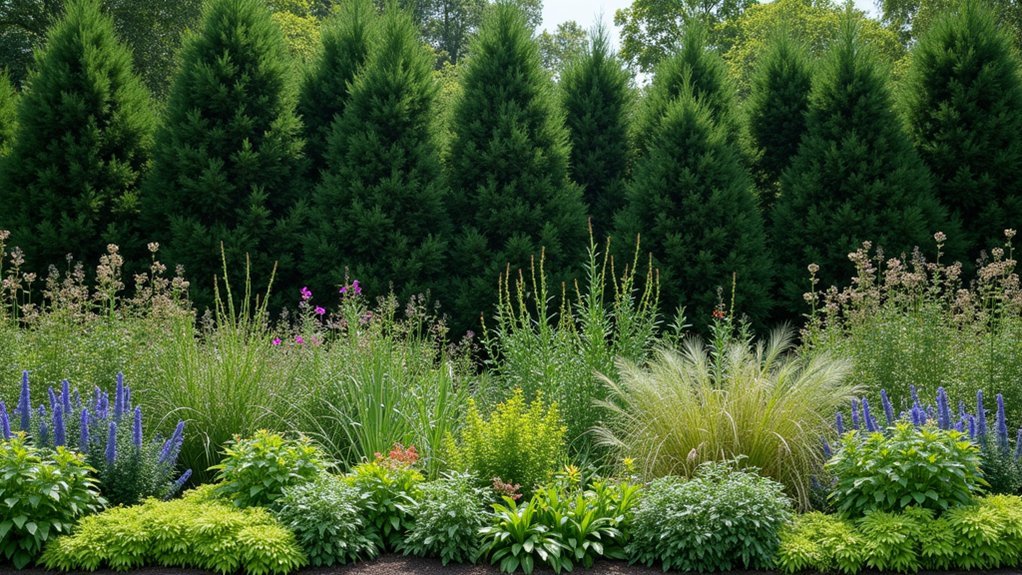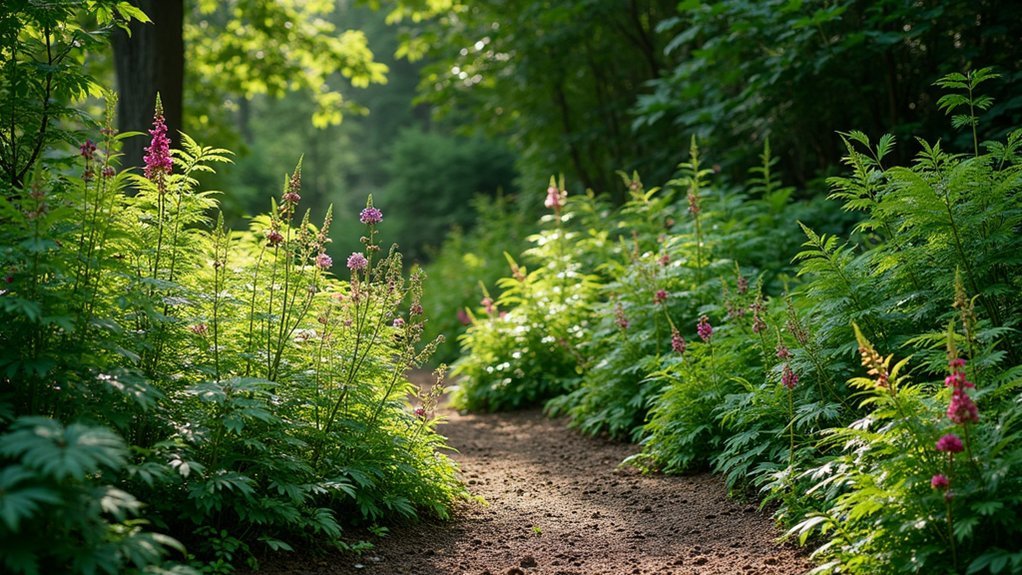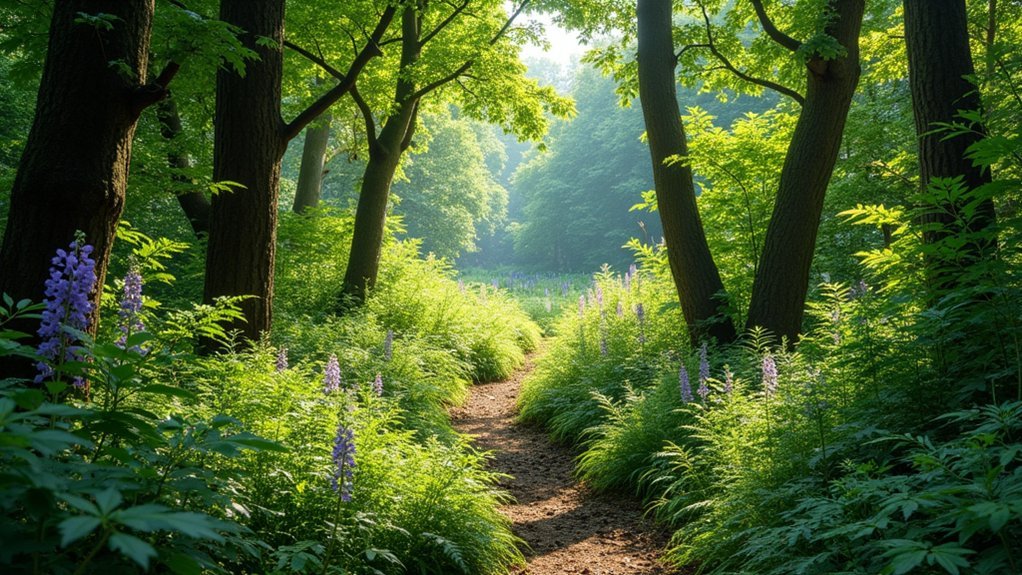Woodland edge plantings offer natural privacy solutions by mimicking forest changes. You’ll achieve the best results with a layered approach—tall trees filtering light for understory shrubs and shade-tolerant groundcovers. Combine evergreens like Polystichum ferns with deciduous varieties such as Viburnum for year-round coverage. This multi-season strategy not only creates an effective screen but also supports local wildlife and enhances biodiversity. Discover how these living borders transform with each passing season.
Woodland Edge Plants for Seamless Privacy Borders

While many homeowners focus on fences or walls for privacy, nature offers far more elegant solutions through woodland edge plants.
Creating layered borders with strategic plantings can transform your garden perimeter into a living screen that changes with the seasons.
Viburnum opulus Roseum stands out as an exceptional woodland shrub, providing dense foliage and stunning lacecap flowers in late spring.
The humble Viburnum opulus Roseum silently transforms garden borders with its lush canopy and delicate spring blooms.
Pair it with evergreen ferns like Polystichum setiferum for year-round coverage and structure.
For the ground layer, Corydalis flexuosa ‘China Blue’ creates a carpet of pale blue blooms that fills gaps effectively.
Incorporate native options such as Erythronium White Beauty bulbs to support biodiversity while establishing your privacy border.
Combining shade-tolerant shrubs with understory plants creates a multi-layered, natural boundary that thrives in woodland conditions.
Understanding the Woodland Edge Ecosystem
Woodland edge shift zones create an ecologically rich boundary where your garden can merge with surrounding natural areas.
You’ll find these unique spaces offer layered light conditions that graduate from full sun to deep shade, creating microclimates that support diverse plant communities.
Transition Zones Matter
Although often overlooked, change zones between wooded areas and open spaces create unique ecosystems that deserve your attention when planning privacy borders.
These transitional zones support remarkable biodiversity, hosting both forest and field species in a single area. When you design your privacy border, you’re actually creating a microhabitat that can strengthen local ecology.
- Trees and shrubs in these zones adapt to varying light conditions, creating a naturally layered appearance perfect for privacy screening.
- The mix of sun and shade creates ideal growing conditions for diverse plant communities that support more wildlife than either forests or fields alone.
- These plantings reduce noise pollution while their root systems help filter runoff and prevent erosion.
Your woodland edge privacy border isn’t just functional—it’s an ecological powerhouse.
Layered Light Conditions
To create a successful woodland edge privacy border, you’ll need to understand how light changes across this dynamic space. Your garden will shift from bright sunshine at the outer edge to deeper shade beneath trees, creating multiple growing opportunities.
This gradient supports a layered planting approach. Taller trees filter sunlight, creating dappled conditions perfect for shade-tolerant shrubs. Beneath them, ferns, hellebores, and corydalis thrive in partial shade, while specialized ground cover plants adapt to the deepest shade.
Take advantage of seasonal light changes by incorporating spring-flowering bulbs and anemones that bloom before the tree canopy fully develops.
When planning your border, carefully balance sun and shade to prevent aggressive sun-loving species from outcompeting your shade-adapted plants. This thoughtful management guarantees a biodiverse, visually appealing privacy screen year-round.
Selecting Multi-Layered Plants for Natural Screening

Creating a natural privacy screen that mimics woodland edges requires thoughtful selection of plants at varying heights and depths. Your woodland garden will feel more authentic when you incorporate native plants like Viburnum opulus Roseum for the tallest layer, complemented by mid-height shrubs and ground-level species.
- Combine evergreens for year-round screening with deciduous varieties that offer seasonal color changes and interest.
- Layer tall trees at the back, medium shrubs in the middle, and low-growing groundcovers at the front to create depth and filter light naturally.
- Choose plants suited to the specific light conditions of your space, especially considering how taller plants will create shade for lower-growing varieties.
This layered approach not only provides privacy but mimics natural woodland structures while supporting local biodiversity.
Shade-Tolerant Shrubs for Dense Privacy Barriers
You’ll find remarkable privacy solutions in shade-tolerant shrubs like *Viburnum opulus Roseum* and *Aucuba japonica*, which create effective multi-layered barriers even in low-light conditions.
Their dense growth habits and varied heights naturally form a woodland edge aesthetic that blocks unwanted views while adding visual interest through seasonal changes.
For year-round screening, combine evergreen options such as Japanese holly with deciduous varieties to establish a living wall that offers privacy regardless of the season.
Multi-Layer Privacy Solutions
When designing a woodland edge privacy border, multi-layered plantings offer the most effective solution for creating natural, dense barriers.
By combining Viburnum opulus Roseum with other shade-tolerant woodland edge plants, you’ll establish year-round screening that mimics natural forest margins.
Mix evergreen and deciduous shrubs and trees for continuous coverage while introducing seasonal interest.
Polystichum setiferum ferns add lush texture beneath taller plantings, creating that authentic forest-edge aesthetic.
- Plant tall background shrubs first, establishing the primary privacy structure
- Fill middle layers with medium-height flowering plants that attract pollinators
- Complete the design with ground covers like Corydalis flexuosa that prevent weeds and soil erosion
Choose native species whenever possible—they’ll require less maintenance and support local wildlife, making your privacy border both beautiful and ecologically valuable.
Year-Round Visual Screening
Effective privacy barriers maintain their screening power throughout all seasons, not just during the lush growth of summer.
You’ll want to incorporate shade-tolerant shrubs like Viburnum opulus Roseum that deliver multi-season interest with flowers, autumn foliage, and bright red berries.
Dense planting of these woodland-edge species creates natural sound barriers while establishing serene atmospheres.
Include evergreen varieties such as Polystichum setiferum to guarantee winter coverage when deciduous plants have shed their leaves.
For continuous visual appeal, select shrubs that flower in different seasons—Helleborus x hybridus offers winter blooms while Corydalis flexuosa brings spring color.
Layering various heights and textures not only maximizes privacy but also promotes biodiversity by creating diverse wildlife habitats.
This strategic approach guarantees your woodland border remains functional and attractive year-round.
Designing Transitions Between Garden and Woodland Areas

Creating a harmonious flow between cultivated garden spaces and natural woodland requires thoughtful planning and plant selection. When designing these passages, employ a layered approach that mirrors the natural structure of wooded areas, where rich soil supports diverse vegetation heights and textures.
- Use native plants like Viburnum opulus Roseum that thrive in varying light conditions and provide seasonal interest at the woodland edge.
- Incorporate natural materials for pathways and seating areas to strengthen the connection between your garden and surrounding woodland.
- Implement a gradient planting scheme with taller shrubs at the back gradually shifting to ground covers at the front.
Maintain these passage zones with organic practices such as mulching and strategic pruning, which will reduce maintenance while preserving the naturalistic aesthetic you’ve created.
Seasonal Interest for Year-Round Privacy Protection
Though privacy needs remain constant, woodland edge plantings should deliver visual interest across all seasons to create truly effective living screens. You’ll want to combine evergreens like Polystichum setiferum with deciduous specimens such as Viburnum opulus Roseum for continuous coverage.
Introduce early bloomers like Helleborus x hybridus to brighten late winter months before trees leaf out. Layer your plantings with varied heights—taller shrubs above, Corydalis flexuosa below—to maintain privacy while showcasing seasonal changes.
| Season | Full Sun Areas | Shaded Areas |
|---|---|---|
| Spring | Viburnum spring blooms | Erythronium White Beauty |
| Summer | Hydrangea quercifolia | Digitalis purpurea |
| Fall | Euonymus alatus | Acer palmatum |
| Winter | Ilex verticillata | Helleborus x hybridus |
| Early Spring | Forsythia | Pulmonaria |
Regular pruning of lower branches encourages ground cover expansion, ensuring your privacy border remains dense and visually appealing year-round.
Frequently Asked Questions
What Is the Best Plant to Block Neighbors’ Views?
To block your neighbors’ views, you’ll find Viburnum opulus Roseum is your best choice. It’s a hardy shrub with dense foliage and large lacecap flowers that provides both privacy and beauty.
What Are the Best Low Maintenance Border Plants?
For low maintenance border plants, you’ll love ferns, hellebores, and wood spurge in shady areas. Corydalis flexuosa China Blue, Viburnum opulus Roseum, and Erythronium White Beauty also require minimal care once established.
What Is the Fastest Growing Plant for Privacy Greenery?
Bamboo is your fastest privacy option, growing up to 3 feet daily in ideal conditions. You’ll also get quick results with Leyland cypress (3-4 feet yearly) or Eastern white pine (2-3 feet annually).
What Are the Best Low Growing Plants for Borders?
For low-growing border plants, you’ll love Corydalis flexuosa China Blue (30cm height), Helleborus x hybridus (30cm with pale yellow flowers), Erythronium White Beauty (20cm), and Polystichum setiferum ferns that provide texture without obstructing views.
In Summary
Creating a woodland edge privacy border lets you transform ordinary boundaries into vibrant, layered ecosystems. You’ll enjoy year-round screening with thoughtfully selected shade-tolerant shrubs while providing valuable habitat for wildlife. By designing shifts that blend seamlessly with existing landscapes, you’re not just gaining privacy—you’re cultivating a living sanctuary that evolves with each season. Your natural border will continue to mature and enhance your outdoor space for years to come.





Leave a Reply